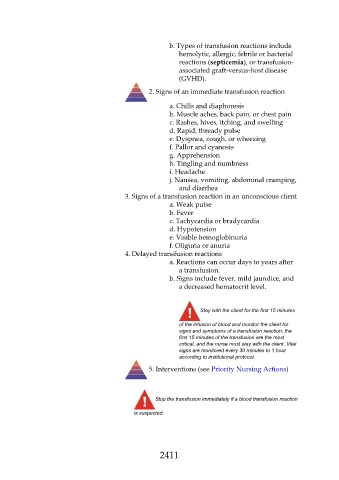Page 2411 - Saunders Comprehensive Review For NCLEX-RN
P. 2411
b. Types of transfusion reactions include
hemolytic, allergic, febrile or bacterial
reactions (septicemia), or transfusion-
associated graft-versus-host disease
(GVHD).
2. Signs of an immediate transfusion reaction
a. Chills and diaphoresis
b. Muscle aches, back pain, or chest pain
c. Rashes, hives, itching, and swelling
d. Rapid, thready pulse
e. Dyspnea, cough, or wheezing
f. Pallor and cyanosis
g. Apprehension
h. Tingling and numbness
i. Headache
j. Nausea, vomiting, abdominal cramping,
and diarrhea
3. Signs of a transfusion reaction in an unconscious client
a. Weak pulse
b. Fever
c. Tachycardia or bradycardia
d. Hypotension
e. Visible hemoglobinuria
f. Oliguria or anuria
4. Delayed transfusion reactions
a. Reactions can occur days to years after
a transfusion.
b. Signs include fever, mild jaundice, and
a decreased hematocrit level.
Stay with the client for the first 15 minutes
of the infusion of blood and monitor the client for
signs and symptoms of a transfusion reaction; the
first 15 minutes of the transfusion are the most
critical, and the nurse must stay with the client. Vital
signs are monitored every 30 minutes to 1 hour
according to institutional protocol.
5. Interventions (see Priority Nursing Actions)
Stop the transfusion immediately if a blood transfusion reaction
is suspected.
2411

